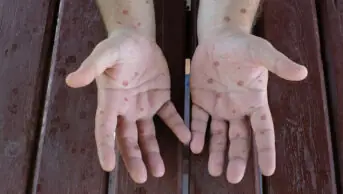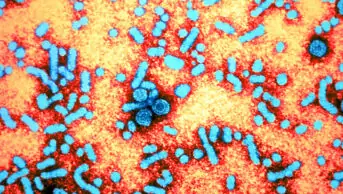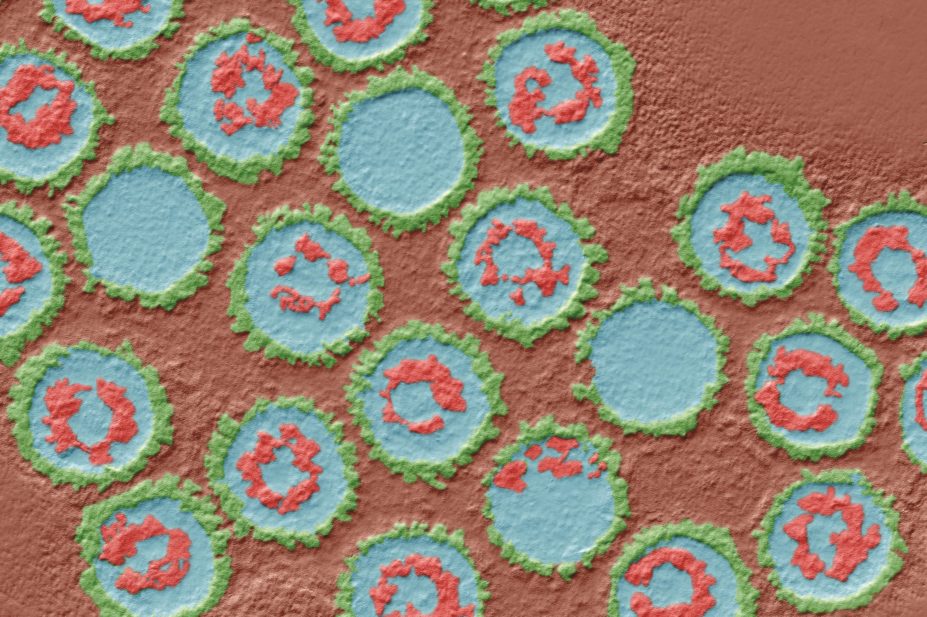
Eye of Science / Science Photo Library
Herpes simplex virus (HSV) is prolific. The strain that most commonly causes cold sores, HSV1, infects about 67% of people aged under 50 years globally. Meanwhile, HSV2, usually responsible for genital herpes, infects about 11% of this population. But the majority of people have no symptoms or very mild symptoms that are easy to miss (approximately 80% of those infected with HSV2). In fact, the most common way to catch either strain of HSV is from someone who sheds the virus without any overt evidence of infection.
The most common complication of HSV is recurrent outbreaks of either oral or genital lesions, which can be distressing and embarrassing for sufferers. Patrick French, a genitourinary medicine consultant at the Mortimer Market Centre in London, says: “The most important job we have is to lessen the psychological impact of an [HSV] diagnosis.”
Nonetheless, the infection can be dangerous under certain circumstances. If passed from a mother to a newborn, for example, HSV can be fatal. And in rare cases, HSV1 can infect the brain, causing encephalitis, which is usually fatal. Genital herpes also increases the risk of HIV infection by 40%.
Antiviral nucleoside analogues can greatly improve outcomes. For patients who suffer repeat attacks they reduce severity and, when taken daily for up to a year, they can be used to suppress outbreaks altogether. Nucleoside analogues were released in the 1980s and they remain the cornerstone of treatment. French says drugs such as aciclovir, marketed as Zovirax, have been “transformative”. Infection with genital herpes can be “nasty” at first, says French, but these drugs have dramatically reduced the rate of complications, such as urinary retention.
But at the moment, HSV infection is lifelong and daily medication can be burdensome. Antivirals are only about 50% effective at reducing transmission, but fortunately, technology is finding new ways to root out the virus inside the body. “A cure that could remove [the latent virus] would be amazing,” says French.
1. New antivirals
Herpes is a longstanding foe of humankind. Its telltale skin lesions were first described by the physician Hippocrates in ancient Greece more than 2,300 years ago. But battle lines were drawn in 1982 with the release of the drug aciclovir, which inhibits viral replication. The nucleoside analogue and its derivatives were the first and remain the only available weapon against herpes. For patients who repeatedly suffer unpleasant symptoms the drugs have been “life changing,” says Patrick French, consultant in genitourinary medicine at London’s Mortimer Market Centre.
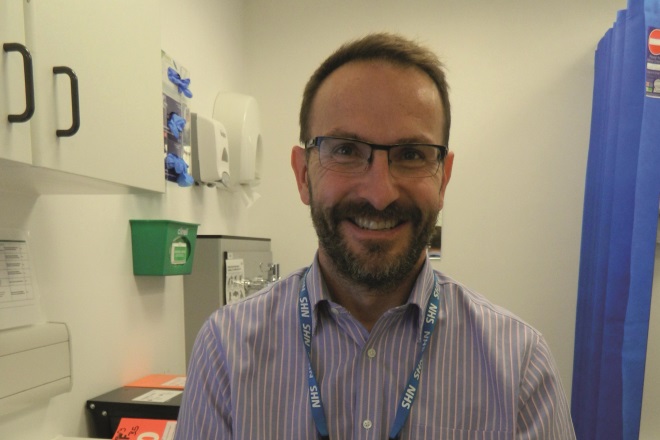
Courtesy of Patrick French
Patrick French, a genitourinary medicine consultant at the Mortimer Market Centre, says that the current antiviral nucleoside inhibitors have been “transformative” for patients with herpes simplex infection
However, despite being effective at reducing symptoms of infection, this treatment has “limitations,” says Anna Wald, a herpes specialist at the University of Washington.
The problem is that nucleoside inhibitors do not “potently” inhibit viral replication. When taken long term, they only reduce transmission of the virus by 50%. And Wald says that they are not adequate for more severe, potentially fatal cases of herpes infection, such as encephalitis and neonatal herpes. To improve on the tools available to fight herpes, a new class of antiviral called helicase primase inhibitors is being developed. These drugs inhibit viral replication, but through a different mechanism to nucleoside analogues.
The first clinical trial of a helicase primase inhibitor pritelivir, developed by German pharmaceutical company AiCuris, was completed in 2011. A daily dose of 75mg reduced viral shedding to only 2.1% of days compared with 16.6% of days in the placebo group among patients with genital HSV2 infection (relative risk 0.13, 95% confidence interval, 0.04 to 0.38)[1]
. A second study involving 91 patients, which compared pritelivir with nucleoside analogue valaciclovir, was subsequently completed in July 2013, but the results have not yet been published, says Wald, who was involved in running both trials. Another helicase primase inhibitor is being developed by Japanese pharmaceutical company Maruho and is currently in phase III trials, but no results have yet been released.
Wald says that she can primarily envisage helicase primase inhibitors being deployed against more severe cases of herpes infection. However, owing to safety concerns involving unexplained skin and haematological findings in monkey models, their use for routine genital herpes “still needs to be worked out”.
2. Therapeutic vaccines
For most people, the body’s defences force the herpes virus into hiding where it causes little upset. However, an unfortunate minority suffers recurrent outbreaks that cause painful ulcers. As a result, some researchers are trying to provide these patients with the same kind of advantage the majority already has.
“Conventional wisdom has been that patients with more mild herpes have an effective T cell immune response,” says Seth Hetherington, chief medical officer at biotechnology company Genocea, based in Cambridge, Massachusetts. The immune system’s T cells are designed to recognise signs of an infection inside a cell, which is where herpes completes most of its life cycle. As such, Genocea hypothesised that for a therapeutic vaccine to successfully control the infection it would need to provoke a T cell response in addition to an antibody response, which is good at controlling signs of infection outside of cells.

Courtesy of Seth Hetherington
Seth Hetherington, Genocea’s chief medical officer, is helping to develop a therapeutic herpes vaccine that he says is “unique” in its ability to stimulate two arms of the immune system
However, the challenge has been identifying what target elicits an effective T cell response. Genocea used its unique technology called ATLAS, which screened every HSV2 protein against the T cells produced by patients with both mild and severe disease. The company then identified a herpes protein called ICP4. Patients who naturally produce T cells that target the protein were found to have a milder HSV2 genital herpes infection. Therefore, Genocea utilised this protein, in combination with another antigen that provokes an antibody response, to develop a therapeutic vaccine for genital HSV2.
Hetherington believes that Genocea’s therapeutic vaccine, called GEN-003, is “unique”. “We believe that both arms of the immune system are needed to get a robust response,” he says.
Around 600 patients with genital HSV2 infection have now been involved in studies to see if GEN-003 can indeed provoke a T cell response and reduce the activity of HSV2. In one phase II study, presented at the 2016 American Society for Microbiology microbe meeting in Boston, Massachusetts, the vaccine reduced viral shedding through the skin by around 50% for at least 12 months compared with viral shedding before vaccination.
This is a similar reduction to that achieved with the only currently available suppressive treatment, a daily nucleoside analogue (see ‘New antivirals’). But there are major advantages to GEN-003. “We know that patients find it tough to take a pill every day,” says Hetherington. In fact, only three doses of the vaccine, given 21 days apart, have been found to reduce the frequency of lesions for at least one year.
As a result, Hetherington believes that GEN-003 could be a suitable alternative for patients who find long-term medication too burdensome. As a doctor who treats patients with herpes, the University of Washington’s Anna Wald says that a therapeutic vaccine would be a “great” option to offer patients, rather than daily medication.
Other companies, such as Sanofi Pasteur, are working on similar therapeutic vaccines, but Genocea’s is “the furthest along,” Wald adds.
In 2016, the company is starting a trial that combines the vaccine with currently available antivirals. For patients who still suffer frequent outbreaks despite daily treatment with antiviral drugs, the addition of the vaccine might provide the symptom relief they need, says Hetherington.
“Using GEN-003 in addition may also reduce viral shedding in between outbreaks, which is the main cause of disease transmission,” he says. Although he adds that Genocea is not specifically testing the effect on transmission.
It may be a few years before patients can access this extra treatment option. Genocea is planning to begin a large phase III study of the GEN-003 vaccine in the second half of 2017. The plan is to submit an approval application to the US Food and Drug Administration in late 2019 and to have the vaccine available for patients by 2020. Hetherington says that a European release is also on the cards, but has not yet been planned out.
3. Preventative vaccines
Vaccines have protected millions of people from a variety of infectious diseases, but not herpes. Despite 50 years of trying, an effective preventative vaccine has eluded scientists.
GlaxoSmithKline developed the first partially effective vaccine, called Simplirix. In clinical trials, 58% of participants were protected against HSV1 but only 20% against HSV2[2]
. The company announced it was dropping the product in 2010.
However, a new vaccine candidate has now emerged and researchers believe they may have figured out what went wrong in previous attempts. Anna Wald, a herpes specialist from the University of Washington, who is not involved in the research, says the data are “very exciting”.
The research team, from the Albert Einstein College of Medicine in New York, published a paper in August 2016, which demonstrates that a new vaccine provides complete protection against a variety of strains of HSV1 and HSV2 in mice[3]
. The HSV strains were isolated directly from patients and, despite different levels of virulence, the vaccine “protects against all of them”, according to William Jacobs, a microbiologist and immunologist from the college who worked on the study.
The reason for the experimental vaccine’s success, the team believes, is because it provokes “an entirely different immune response” to previous vaccines, says Betsy Herold, who is director of the translational prevention research centre at the college. Unsuccessful vaccine candidates, such as Simplirix, have contained a component of the virus’s outer coat, called glycoprotein D, which is essential for entry into host cells. The immune system reacts to glycoprotein D by producing neutralising antibodies. In contrast, the vaccine developed by Albert Einstein College of Medicine lacks glycoprotein D. And the antibodies that the immune system produces are not neutralising antibodies, but ones that recruit cytotoxic T cells, the killers of the immune system that destroy infected cells[4]
.

Courtesy of Betsy Herold
Previous attempts to develop a preventative vaccine for herpes have been unsuccesful, but Betsy Herold, a researcher at the Albert Einstein College of Medicine, is helping to develop a promising new strategy
“Ours is the only vaccine with this type of antibody response and a critical finding is that it worked very well against HSV1 and HSV2,” says Herold.
The team are currently testing the vaccine in a range of animal models, and Herold says it has shown similar protection in all studies. But Wald cautions that it’s “very hard to tell if a vaccine will work in humans from animals, it’s easier to prevent infection in a mouse”. If all goes well, the researchers hope to begin small clinical trials by 2018.
4. CRISPR/Cas9
Herpes is a talented squatter. Once it takes up residence in the body, it never leaves. During the initial infection, the virus rapidly heads to local nerve cells where it establishes a permanent home. It remains inactive but is poised to periodically strike out. Even if you are one of the lucky ones who has no symptoms, the virus can re-emerge, replicating itself and shedding infectious viral particles through the skin.
But now researchers believe they may have developed a way to permanently remove this unwelcome guest. They are using a gene editing tool, CRISPR/Cas9, which can target and cut specific sections of DNA. At Temple University in Philadelphia, Pennsylvania, researchers are using the technique to target viruses, crippling their ability to replicate.
The idea is to “eliminate the virus completely”, says Kamel Khalili, chair of the university’s department of neuroscience. The strategy has already had some success at treating HIV in pre-clinical studies. Now, the researchers have adapted the technology to target the herpes simplex genome and are currently studying it in animal models. Although the results are not yet available, it’s looking “very promising”, Khalili adds.
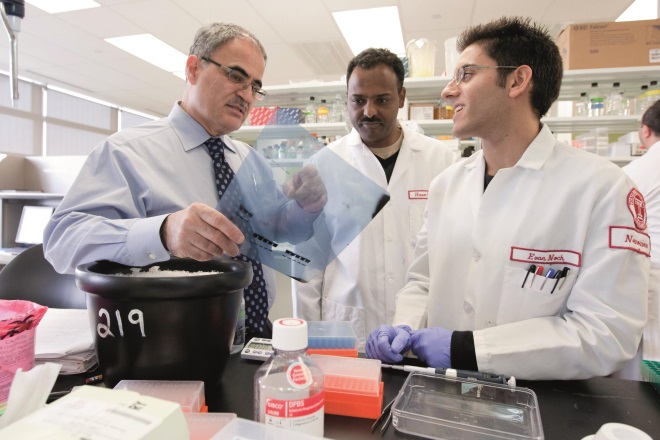
Source: Courtesy of Kamel Khalili
Kamel Khalili at Temple University is using CRISPR/CAS9 gene editing technology to try to eliminate the herpes simplex virus from infected individuals
Two different sections of herpes DNA were targeted in laboratory studies, which reduced viral replication to zero in infected nerve cells[5]
. The targeted DNA sequences were from HSV1 but identical to the HSV2 sequences, meaning that it “should work for both”, says Khalili. In animals, the system can either be applied topically to the skin or packaged in an inert virus that transports it to infected cells deeper in the tissues. It “appears to be extremely safe”, Khalili says, with no effect on the cell’s own DNA sequence.
The technology developed by Temple University has already been used to establish a biotechnology company called Excision Biotherapeutics, also based in Philadelphia, in which Khalili is a stakeholder. In six months, the company hopes to have completed the animal studies and is “rapidly advancing towards the clinic”, he says. And if all goes well, Khalili says the treatment will be available for patients in less than five years and “could be used for whoever has the virus”.
References
[1] Wald A, Corey L, Timmler B et al. Helicase-primase inhibitor pritelivir for HSV-2 infection. New England Journal of Medicine 2014;370:201–210. doi: 10.1056/NEJMoa1301150
[2] Belshe R, Leone P, Bernstein D et al. Efficacy results of a trial of a herpes simplex vaccine. New England Journal of Medicine 2012;366:34–43. doi: 10.1056/NEJMoa1103151
[3] Petro C, Weinrick B, Khajoueinejad N et al. HSV-2 ΔgD elicits FcγR-effector antibodies that protect against clinical isolates. JCI Insight 2016:1:e88529. doi: 10.1172/jci.insight.88529
[4] Petro C, Gonzalez P, Cheshenko N et al. Herpes simplex type 2 virus deleted in glycoprotein D protects against vaginal, skin and neural disease. eLIFE 2015;4:e06054. doi: 10.7554/eLife.06054
[5] Roehm P, Shekarabi M, Wollebo H et al. Inhibition of HSV-1 replication by gene editing strategy. Scientific Reports 6, article number 23146. 2016. doi: 10.1038/srep23146

